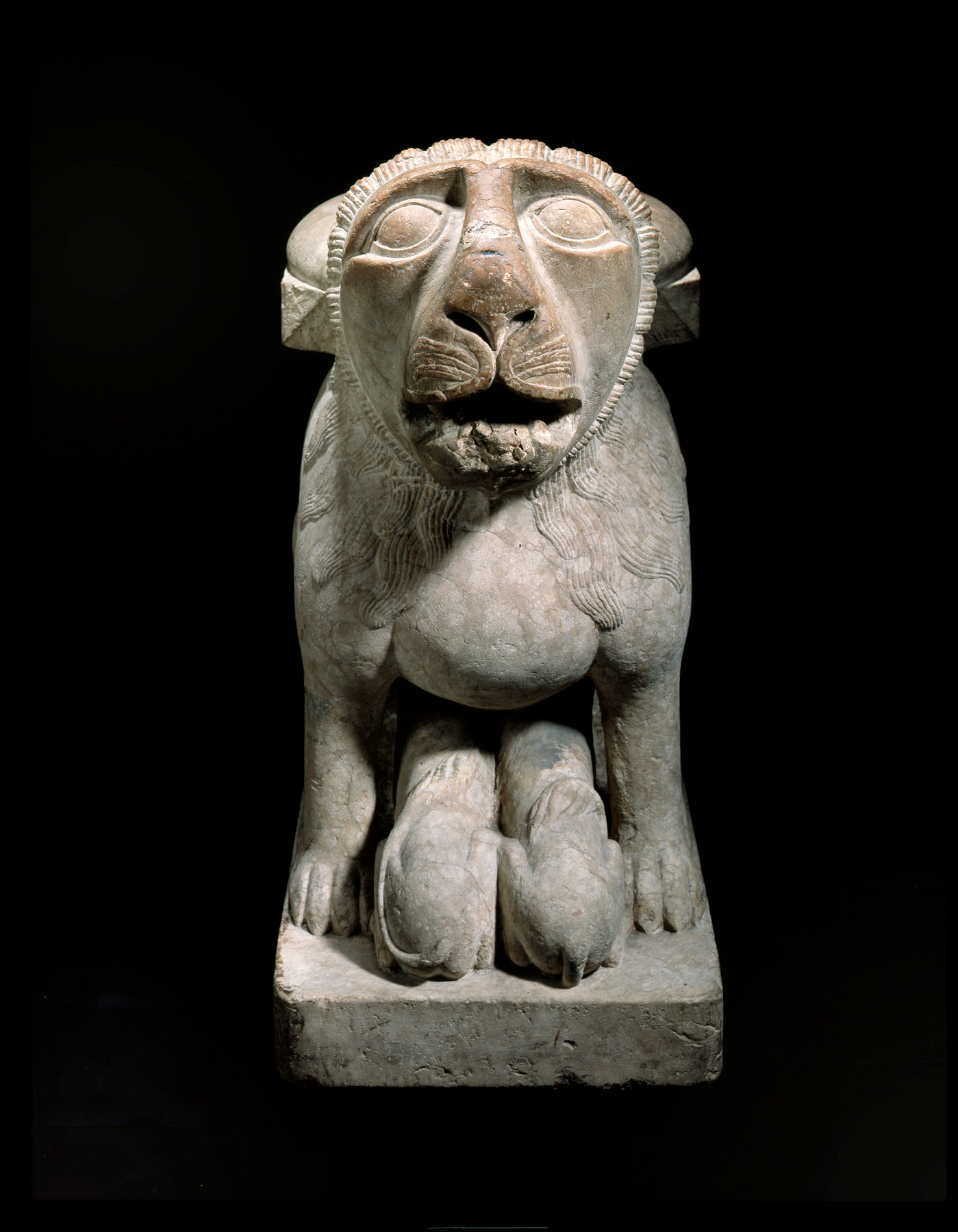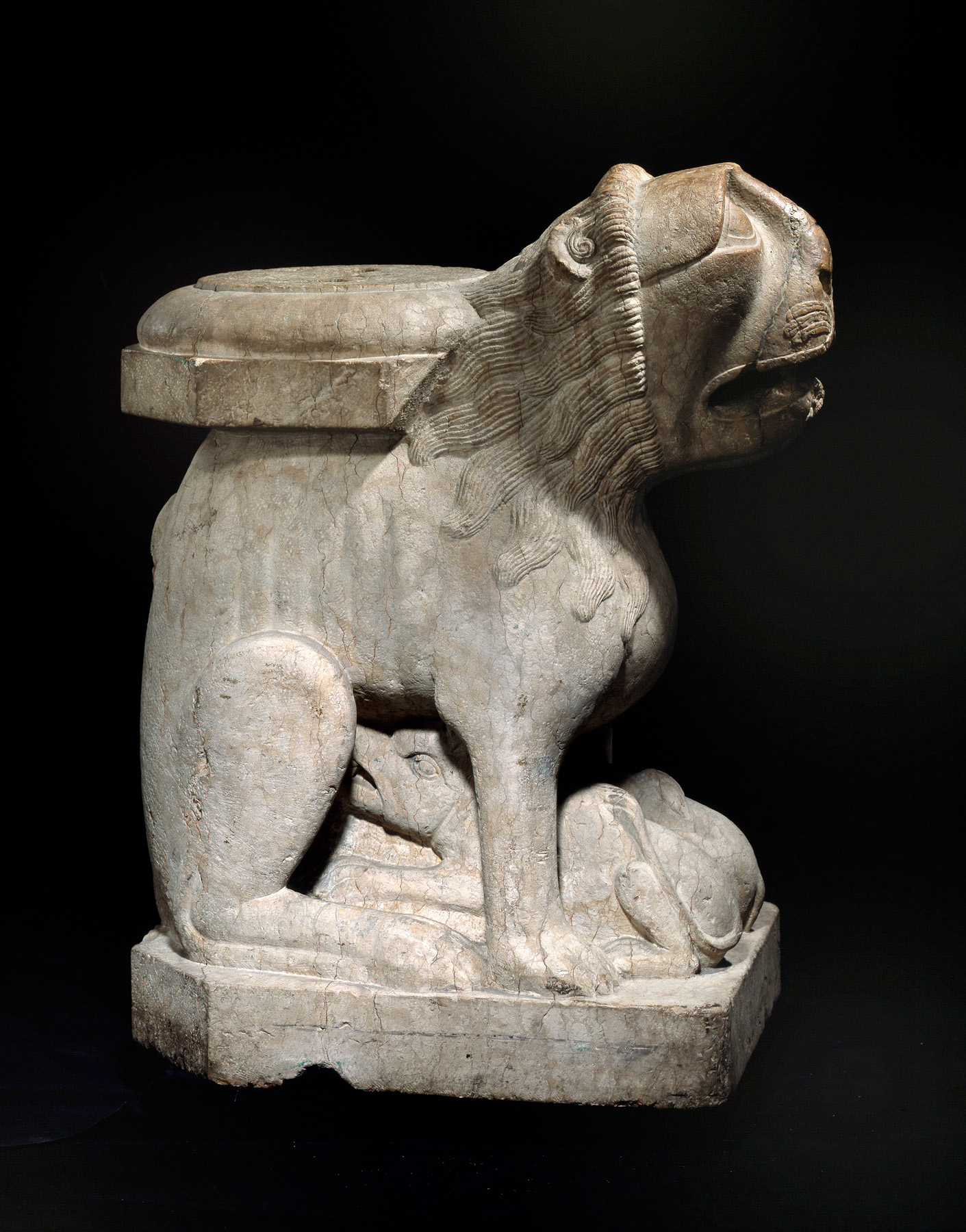Description
Guardian of the house of God, symbol of force and justice, these stylophore lions were developed in Northern Italy at the beginning of 12th century. This lion motive, specific to religious architecture, spread widely at that time.
The term stylophore comes from Greek, meaning pillar support. The lion stylophores were originally entrusted by the people of the Middle Orient, the Sumerians, the Hittites, the Assyrians and also the Egyptians and the Greeks to guard their holy shrines.
The lion then invaded the churches, ornamenting not only the facades but also the interiors. It could be found on the baptismal basin, on the altar, the eîscopal seat or the pulpit and was considered symbol of force and justice.
The great door was of huge importance in Roman art. Defenders of the great door are specific to Roman art whether it be in the form of lion column supports or of multiple aspects on the tympanum.
The idea of defence seems to dominate here, however it is by way of protection rather than prohibition. In Romanesque art, the lion “defenders” can be explained by the fact that bandits often used to go under cover as pilgrims to go unnoticed.
When the atlantes of the church symbolise wisdom and knowledge, the lions are the defensive and protective element. Successors of a long Mesopotamian and Egyptian tradition, these two symbols no longer have the same significance. They simply invite to enter the church with respect.
DESCRIPTION
The lioness sits on her hind legs, her front legs are upright and between them are two suckling cubs. The two cubs are visible from the side, with their heads concealed beneath their mother. One sits on its tail which reappears on its back, whereas the other’s sprawls up to the nape of its neck.
The mother has a full mane carved with grooved curvilinear locks which extend backwards from a smooth ring circling the head.
The large oval eyes gaze upwards. The top of the nose is rendered in a series of horizontal ridges. The front of the snout has three low relief grooved whiskers which splay out from the center.
The side of the torso has five or six grooves which mark the ribs. An upward curving tail with a full tuft at the end is carved in low relief on the back. The lioness carries the base of the column on her back. It is sculpted into the same piece of marble and pierced in the middle with three cavities, assuring greater stability for the column.
The mottled pink stone is weathered to near white.
COMPARATIVE STUDIES
Our lioness stylophore is very similar in size and of the same material as the one supporting a font in the baroque Cathedral San Pietro in Bologne.
The sitting, suckling lioness from Cathedral San Pietro is considered, along with two other reclining portal lions from the same cathedral, to have been originally from one of the great doors of the earlier Romanesque cathedral, called the “Portal of the Lions”. The lions are dated 1220 and attributed to an architect and sculptor called Maître Ventura a Marchione.
(A. Manaresi, La “Porta dei Leoni” nell’antica Cattedrale di Bologna, Bologna, 1911, pp. 9-10, fig. 3)
Another sitting lioness, also suckling her cubs, in Verona marble is kept in the Herbert F. Johnson Museum of Art of Cornell University in Ithaca (USA). It is identical in size to the lion that we present here and would also definitely have come from Bologna, perhaps from the same former portal.
(W.D. Wixom in Medieval Art in Upstate New York, Syracuse, 1974, n°. 23, pp.39-42, repr.)
Further related pieces, once a part of the Ferguson house and estate, have survived. There are two monumental supporting lions in pink Verona marble and three marble capitals, which may have once been pulpit supports. These five pieces belong now to the Cleveland Museum of Art. Additional architectural elements, columns and simple capitals with the same recent history are in a private collection in Kansas.
Comparative study suggest that all of the sculptural pieces come from the same Emilian workshop. Continuing investigations suggest that the entire group was carved in Bologna at the end of the twelth century. Interesting comparisons may be made with similar stylistic details found on the figured capitals in the upper logia of Santo Stefano. These capitals have been attributed to a certain Master Pietro di Alberigo, activ from ca. 1164 to the early thirteenth century.
Continuing research will eventually be published and will include all known pieces from what have been a very prominent Bolognese workshop active at the end of the twelfth century and in the first years of the thirteenth century.
(Ex Collection: Juliana Armour Ferguson, Huntington, Long Island
William D. Wixom, Cleveland Museum)
EDWARD TUCK
American art collector and patron.
Born in Exeter, New Hampshire in 1842. Died in Monte Carlo in 1938.
With his wife Julia Stell (who died in 1928) they decided to settle down in France and the country benefitted from their generosity.
As benefactors of the town of Rueil they maintained a military hospital during the First World War, as well as a number of charitable organisations. They received the Prize Virtue, awarded to them by Franch Academy in 1916.
In 1926 the Tucks donated their Boispréau estate so it could be joined with the Parc de Malmaison.
In 1930 they offered their collections of 18th Century tapestries, paintings (Cranach, Cima da Conegliano, Greuze) and porcelains, to the city of Paris. These collections are now curated by the Museum of Petit Palais.
William Wixom’s article
LIONESS
ITALIE, EMILIE, (BOLOGNE), fin du XIIème siècle
Weathered pink marble. H. 32 ½”, W 15 ½”, D. 26”
Herbert .. Johnson Museum of Art, cornell University. N° 73.11
The lioness sits on her haunches ; her front legs are uprightand between them are two suckling cubs. The mother has a full mane carved with grooved curvilinear locks which extend backwardsfrom a smooth ring circling the head.
The large ovale eyes gaze upward. The top of the nose is rendered in a series of horizontal ridges. The front of the snout has three low relief grooved whiskers which splay laterally from the center. The side of the torso has five or six grooves which delineate th ribs.An upward curving tail with a full tuft at the end is carved in low relief on the back. An octogonal column base with a curved molding is carved in one piece with the sculpture, although it appears at first to have been butted into the mane and back.
The chief losses are those of the jaw and right front paw of the lioness and parts of her two cubs and the supporting base below. The mottled pink stone is weathered to near white. The missing parts not yet lost when the lioness was set up as part of a fountain in the garden of Mrs. Juliana Armour Ferguson at Huntington, Long Island.
Related pieces, also once a part of the Ferguson house and estate, have survived. The are two monumental supporting lions in pink marble and three marble capitals which may have once been of pulpit supports. These five pieces belong now to the Cleveland Museum of Art. Additional architectural elements, columns and simple capitals with the same recent history are in a private collection in Kansas. Comparative study suggest that all of the sculptural pieces come from the same Emilian workshop. Continuing investigations suggest, in refinnemnt of the attribution, that the entire group was carved in Bologna at the end of the twelf century. Interesting comparisons may be made with similar stylistics details found on the figured capitals in the upper logia of Santo Stefano. These capitals have been attributed to a certain Master Pietro di Alberigo, activ from ca. 1164 to the early thirteenth century.
Also there are even more striking similarities to be seen in two reclining portal lions and a single sitting, suckling lioness in the Cathedral of San Pietro also in Bolonia. These three lions have been have been thought to have come from the destroyed lateral portal of the earlier Romanesqueee cathedral. This portal was called the “Portal of the Lions.” Two sixteenth-century descriptions of this doorway tantalizingly vague. These are by Fra Leandro Alberti and Giogio Vasari. Vasari, who says the work is by certain Ventura a Marchione, gives the following account :
“About the same time Marchione also made the side door of San Pietro in Bologna, which was truly for thoses times a work of the greatest mastery, by reason of the many carvings that are seen therein, such as lions in the round that sustain columns, and men in the use of porters, and others animals that support weights; and in the arch above he made the twelve months in full reief, with various fancies, and vfor each month its clestial signe; which work must have been held marvelous in those time.”
The suckling lioness preseved in the extand Baroque cathedral is a very close sister to the Cornell lioness. Despite current unavaaillability of requested messurements, it is tempting to assign the Cornell lioness to this former and famous portal.
There are others sculptures which must be considered within this general context.
Continuing research will eventually be published and will include all known pieces from what have been a very prominent Bolognese workshop active at the end of the twelfth century and in the first yars of th thirteenth century.
Ex Collection: Juliana Armour Ferguson, Huntington, Long Island
William D. Wixom, Cleveland Museum


